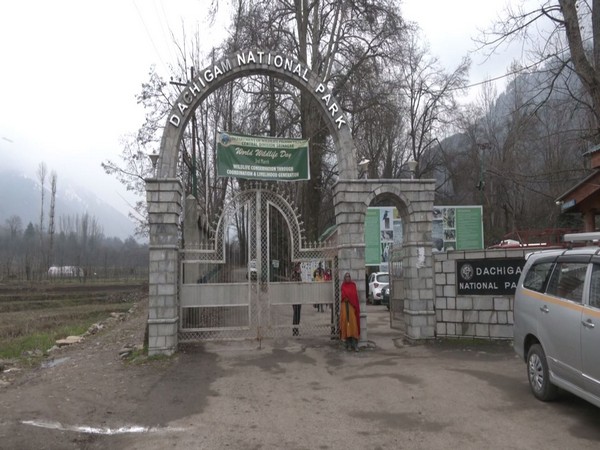J-K: Dachigam National Park welcomes endangered Red Deer species 'Hangul'


Srinagar (Jammu and Kashmir) [India], May 30 (ANI): After a herd of endangered Hangul (Kashmir Stag) was spotted at Dachigam National Park in Jammu and Kashmir in March, hope was sparked in the conservation department, a win much needed considering the feared extinction of the Red Deer.
The only habitat of Kashmir Stag or Hangul, Dachigam National Park lies in the Zabarwan Range of the Western Himalayas in an area of 141 sq km, with variable elevations from 5,499 ft (1676 m) to 14,000 ft (4267 m).
It boasts of deep valleys, rocky ridges, steep wooded hills, and the alpine pastures of Srinagar. Dachigam or 'Dah-Chi-Gam' literally refers to ten villages that existed here before World War 1 in 1914. The villages were evacuated to create a place for water supply for the city of Srinagar during the reign of Maharaja Pratap Singh.
The Himalayan range is the most spectacular natural wonder - the highest, youngest and largest chain of mountains in the world. It is one of the richest stores of animal life. It gives home to one-third of the world's mountain mammalian species.
The mountainside of the park has coniferous forests sprinkled with alpine carpets, meadows, waterfalls, and scrub vegetation. Flowers grow wild as far as the eyes can see. The Dagwan River flows through the National Park, pregnant with trout throughout the year.
Locally known as Hangul, the Kashmir stag (CervusElephusHanglu), native to Kashmir, is one of the most endangered species of Red Deer in the world. This was first identified by the researcher Alfred Wagner in 1844.
Other wild animals native to these mountains are Snow Leopard, Musk Deer, Kashmiri Grey Langur, Himalayan black and brown bear, a variety of cats and foxes, and a few species of wild goats like the Markhor and Ibex. Exotic birds fill the skies here - Cinnamon Sparrow, Black Bulbul, Himalayan Monal, Golden Oriole, Kashmir Flycatcher, Crimson Tragopan, Iridescent Monal Pheasant, Blood Pheasant, and Koklass Pheasant, to name a few.
Gliding higher than these are the Golden Eagle and the Bearded Vulture. Dachigam National Park is blessed with nature's bounty in the form of Wild Cherry, Pear, Plum, Peach, Apple, Apricot, Walnut, Chestnut, Oak, Willow, Poplar, Chinar, Birch, Pine, and Elm. Jammu and Kashmir government declared Dachigam as a sanctuary in 1951 and as a National Park in 1981.
The Tourism Department together with the Forests and Wildlife Departments will be organizing a first-of-its-kind Bird Festival in Dachigam and Pahalgam to promote sustainable ecotourism and allow locals to participate in nature-based alternative sources of livelihood. New trails for bird watching across J&K are being tracked down to the market this activity as a sustainable hobby.
Earlier in March, a herd of fifty Kashmir Stag was spotted at Dachigam. This episode has given hope to the conservation department, a win much needed considering the feared extinction of the Red Deer.
According to the Wildlife Department, there are probably a few more herds of the same size in the Park. In the early 20th century, there were about 5,000 Hangul but due to hunting and encroachment, the population fell to 150 in 1970. In 2019 that number rose to 237.
The Department of Wildlife Protection is regularly maintaining reservoirs of food and water for the Hangul. In the last 2-3 one lakh fruit trees have been planted in the Dachigam Park along with water holes for safe drinking water. Fresh vegetables and salt licks are positioned in particular hotspots daily by the Park employees. A sturdy fence has been built in areas where the chances of man-animal conflict are common.
On 4th March the Department celebrated World Wildlife Day by organizing a series of programs in Kashmir. At Dachigam Park, local youth and representatives were apprised of the need to preserve wildlife. A few short films and documentaries were screened. Later the celebration was given life with an outstanding folk music program on the theme of being connected to nature through forests and wildlife.
A year ago the Center declared 137.75 sq km around Dachigam National Park, Thajiwas (Baltal), and Overa Aru Wildlife Sanctuaries as eco-sensitive zones. It has put an end to mining and stone quarrying activities in the area - an effort in the direction of Hangul preservation.
In March a pregnant female Hangul was found dead, probably prey to a leopard in Shikargah Wildlife Sanctuary of Tral area of South Kashmir. As at this time of the year pregnancy is usually in advanced stages, this event suggests successful breeding in the area. This is also the first time a Hangul has been spotted outside Dachigam, perhaps marking the beginning of their return to the Valley. (ANI)
Source: WORLD
